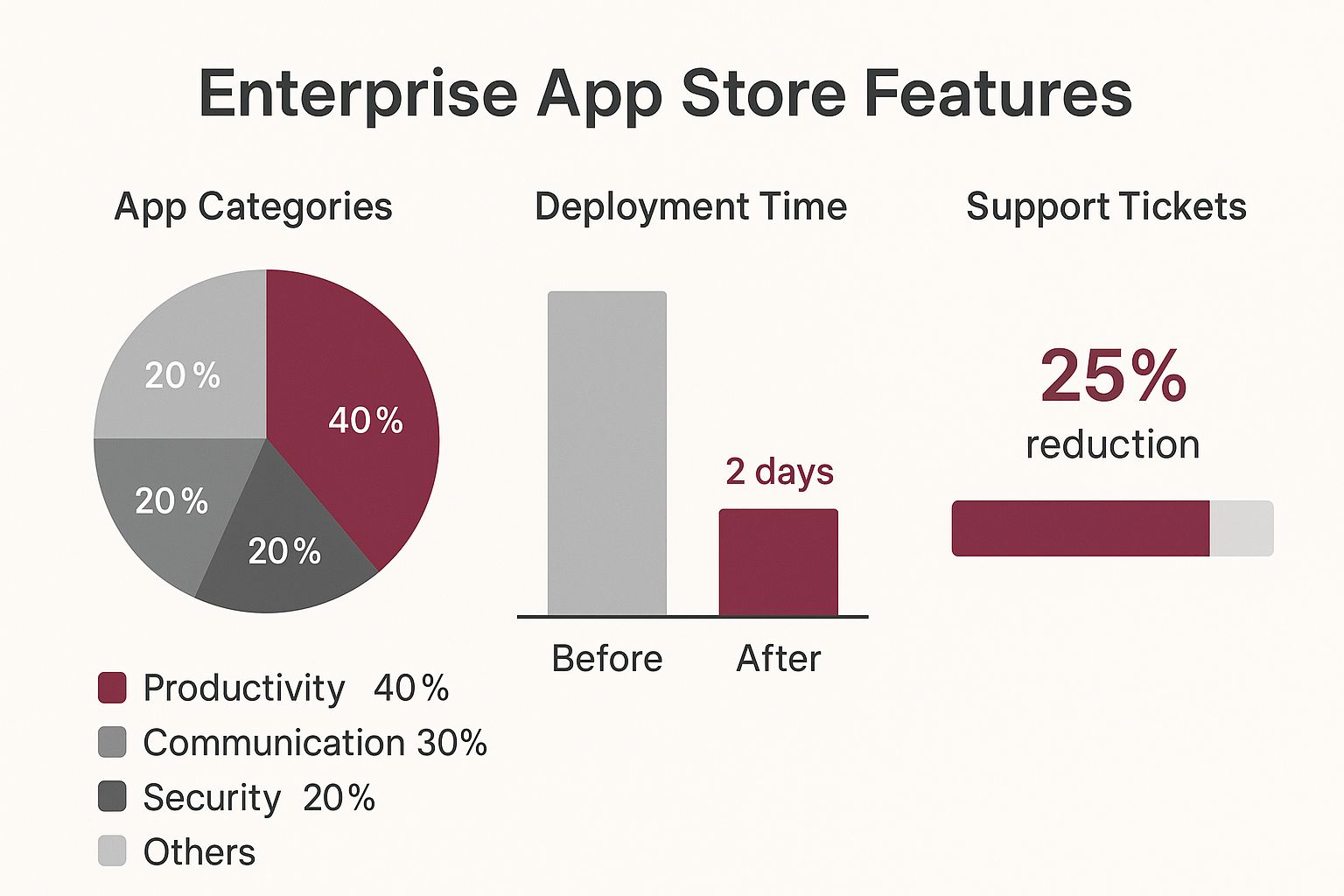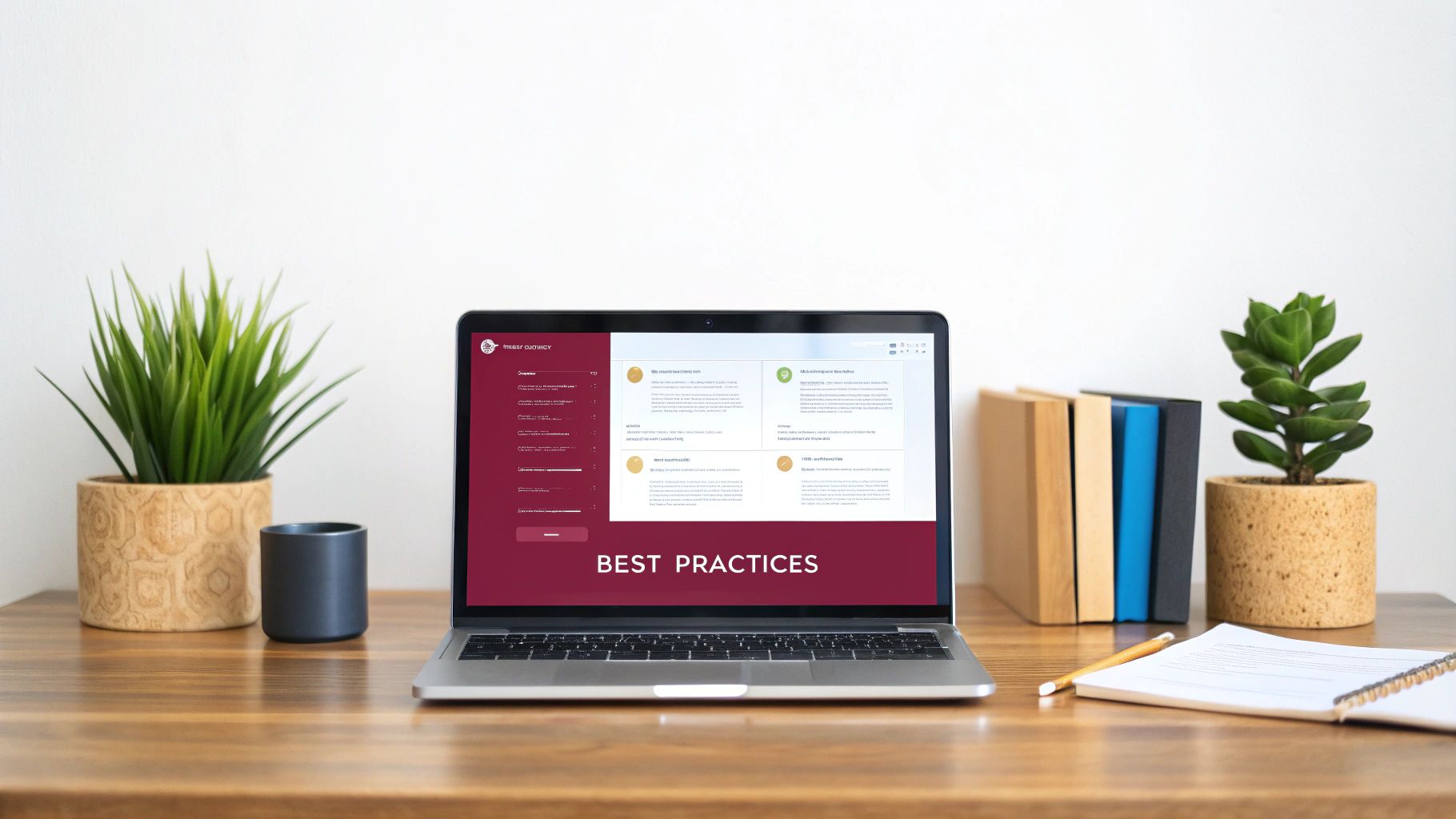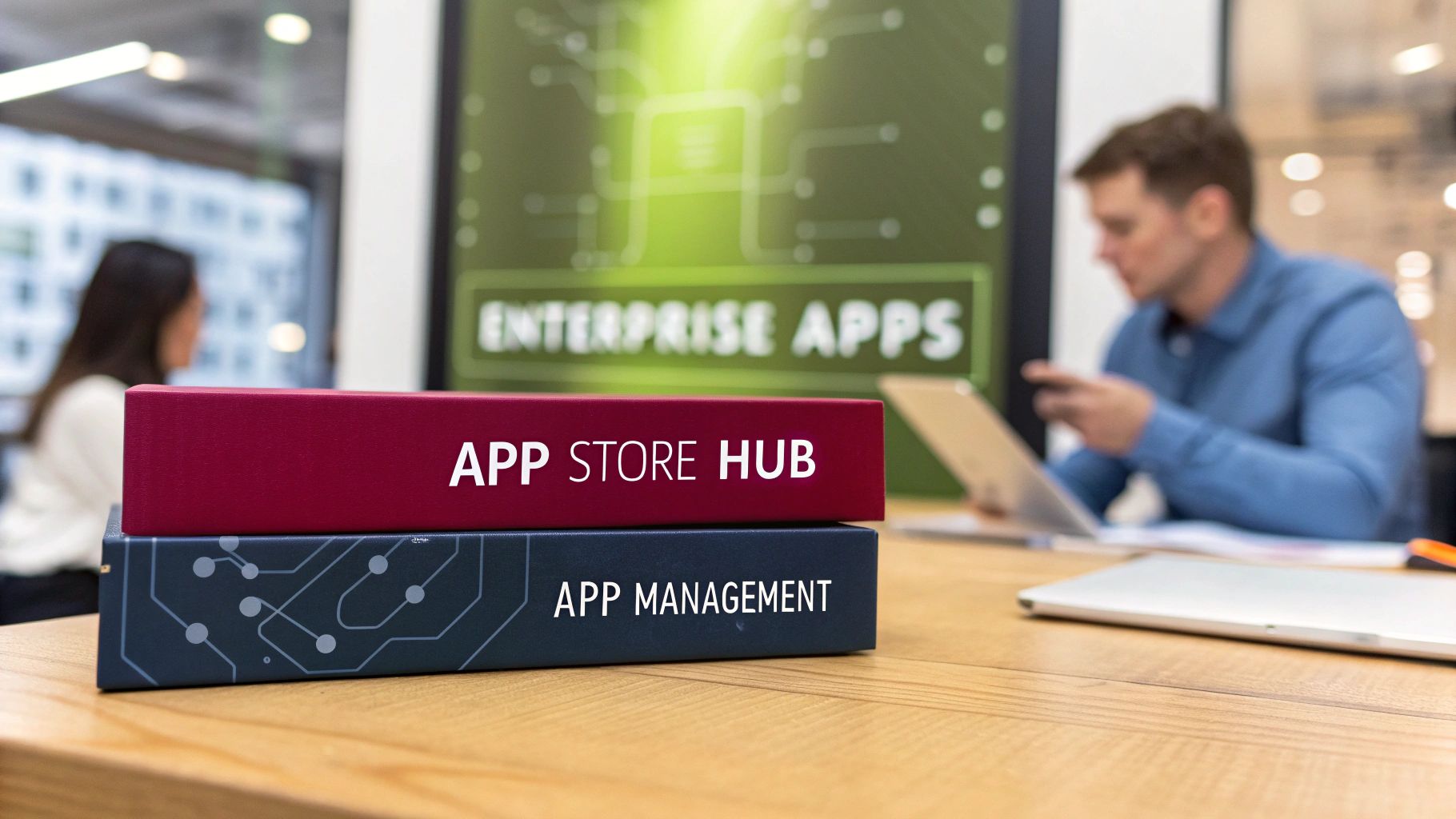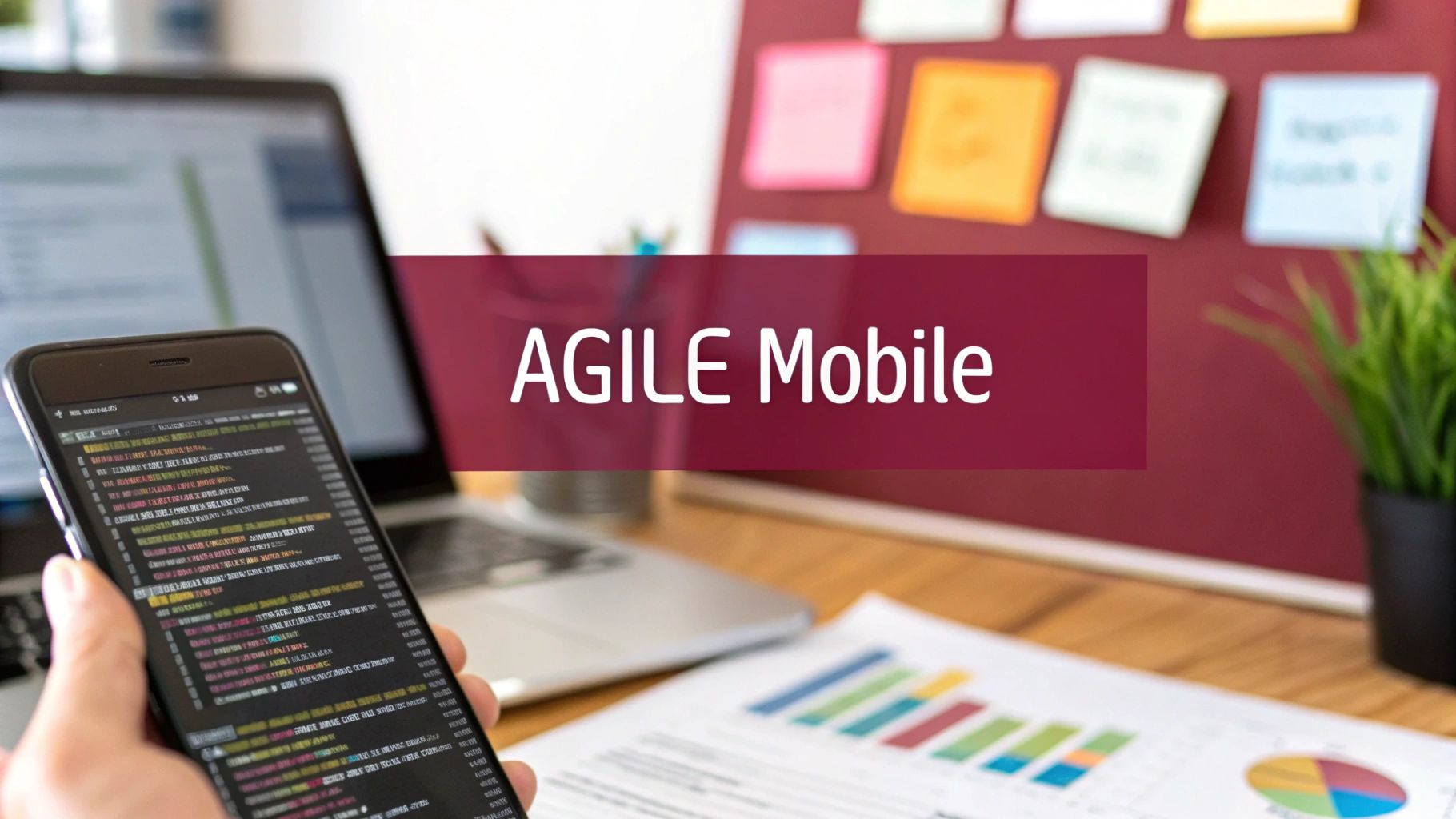Understanding Enterprise App Stores in Modern Business

Let’s clarify what enterprise app stores are and why they’re so important for today’s businesses. These platforms are distinct from public app stores like Google Play or the Apple App Store. Enterprise app stores cater to the specific needs of an organization, providing a central hub for managing and distributing apps to employees. This centralized approach simplifies providing employees with the necessary tools.
Key Differences Between Enterprise and Public App Stores
One key difference is the target audience. Public app stores serve a broad consumer base, while enterprise app stores focus exclusively on internal employees. This allows organizations to curate apps relevant to their business operations. For instance, an enterprise might include proprietary in-house apps, specialized industry tools, or customized versions of standard productivity software.
Another crucial difference is security and control. Enterprise app stores offer granular control over app distribution, ensuring only authorized personnel access specific applications. This is particularly important for industries with strict compliance regulations. IT departments also gain control over app updates, ensuring consistency and security across the organization.
Finally, streamlined deployment is a major benefit. Enterprise app stores allow IT to quickly deploy apps to many devices simultaneously, eliminating tedious individual installations. This reduces IT overhead and ensures employees have the latest tools. These deployments can also be managed remotely, simplifying updates and installations.
The Growing Importance of Enterprise App Stores
The increase in mobile work and bring-your-own-device (BYOD) policies has driven demand for efficient app management solutions. Enterprise app stores provide the necessary infrastructure to securely support these trends. They offer a way to maintain control over data and access, even on personal devices.
This growing need is reflected in current market trends. The enterprise app store software market is expanding rapidly. In 2023, the market was valued at $241 billion USD. Projections suggest it will reach $480.75 billion by 2031, growing at a CAGR of 7.2% between 2024 and 2031. More detailed statistics can be found here: Verified Market Research
Benefits of Implementing an Enterprise App Store
Implementing an enterprise app store offers numerous advantages:
- Improved Productivity: Easy access to the right tools allows employees to work more efficiently.
- Enhanced Security: Centralized control minimizes security risks and ensures regulatory compliance.
- Reduced IT Costs: Streamlined deployment and management decrease IT overhead and support costs.
- Increased Employee Satisfaction: A user-friendly app experience improves morale and productivity.
The need for efficient and secure app management will only increase as businesses rely more on mobile technology. Selecting the right enterprise app store solution is crucial for any organization aiming to succeed. This requires careful consideration of your specific needs and goals.
Cloud vs On-Premise: Choosing Your Deployment Strategy
Choosing the right deployment strategy for your enterprise app store is a crucial decision, impacting security, scalability, and cost. This choice aligns with your organization’s overarching goals. The two primary models are cloud-based and on-premise, each with its own advantages and disadvantages.
Cloud-Based Enterprise App Stores
Cloud-based deployments offer compelling benefits, especially for small and medium-sized enterprises (SMEs). These solutions are typically faster to implement and require less upfront investment. Organizations can quickly establish an enterprise app store and start realizing the benefits without significant capital expenditure. Cloud providers handle the underlying infrastructure, reducing the burden on internal IT teams. This frees up resources for other strategic projects.
-
Rapid Deployment: Cloud solutions can be up and running in days or weeks, compared to months for on-premise deployments.
-
Cost-Effectiveness: The subscription-based model of cloud services eliminates the need for expensive hardware and software licenses.
-
Automatic Updates and Maintenance: Cloud providers handle updates and maintenance, ensuring the app store always runs the latest version.
-
Scalability: Cloud resources can easily scale up or down as your needs change.
On-Premise Enterprise App Stores
Larger corporations with stringent security and compliance needs may prefer on-premise deployments. Organizations retain complete control over their data and infrastructure. This provides a higher level of security and allows for tailoring the app store to specific needs. However, this control comes at a cost. On-premise deployments require significant upfront investment in hardware and software, along with ongoing maintenance and support.
-
Enhanced Security and Control: Organizations have complete control over their data and security policies. Check out our guide on enhancing cloud security.
-
Customization: On-premise solutions can be tailored to meet specific organizational requirements.
-
Compliance: For industries with strict regulations, on-premise deployments offer a more compliant environment.
The following infographic visualizes key data about enterprise app store features, including app category distribution, deployment time comparison, and a reduction in support tickets.

Implementing an enterprise app store can significantly streamline operations. The faster deployment time and reduction in support tickets highlight the efficiency gains these platforms offer. The app category distribution shows how organizations tailor their app stores to meet specific business needs. Market projections indicate continued sector growth. From 2024 to 2028, the market is estimated to grow by USD 4.58 billion, with a CAGR of approximately 18.51%. This growth is driven by increasing demand for cloud-based solutions, which offer flexibility and scalability. Explore this topic further here.
To help you further evaluate the different approaches, we’ve compiled a comparison table:
Cloud vs On-Premise Enterprise App Store Comparison: Detailed comparison of deployment models including costs, security, scalability, and maintenance requirements
| Feature | Cloud-Based | On-Premise | Hybrid |
|---|---|---|---|
| Cost | Subscription-based, lower upfront cost | High upfront cost for hardware and software | Moderate upfront cost, depends on cloud usage |
| Security | Dependent on provider’s security measures | Full control over security | Control over on-premise data, reliance on cloud provider for cloud-based data |
| Scalability | Easily scalable | Scalability requires hardware upgrades | Scalable on the cloud side, on-premise scalability limited |
| Maintenance | Managed by provider | Requires dedicated IT staff | Shared responsibility for maintenance |
| Deployment Speed | Fast, days to weeks | Slow, months | Moderate, depends on complexity |
| Customization | Limited by provider’s offerings | Highly customizable | Customizable on-premise, limited in the cloud |
| Compliance | Dependent on provider’s certifications | Easier to meet specific compliance requirements | Compliance requirements must be met for both environments |
This table highlights the key differences between cloud-based, on-premise, and hybrid solutions for enterprise app stores. Cloud solutions are cost-effective and quick to deploy, while on-premise offers greater control and security. Hybrid approaches offer a middle ground, allowing businesses to leverage the benefits of both.
Hybrid Approach
Some organizations opt for a hybrid approach, combining the benefits of cloud and on-premise deployments. This model allows for phased cloud migration, enabling organizations to transition gradually while maintaining control. Sensitive data can be stored on-premise, while less critical applications reside in the cloud. This flexible approach is a good compromise for organizations with complex needs. The optimal deployment strategy depends on your organization’s specific security posture, budget, and growth trajectory.
Building Bulletproof Security and Compliance Frameworks
Security is paramount for enterprise app stores. It’s the foundation of trust and smooth operations. This section explores the multi-layered security approaches essential for protecting your valuable digital assets within an enterprise app store. These layers include everything from stringent app vetting to advanced user access controls and robust encryption.
Application Vetting and Approval Processes
A crucial first line of defense is a rigorous application vetting process. Before any app enters your enterprise app store, it undergoes thorough scrutiny. This includes analyzing the application’s code for vulnerabilities, verifying its source, and ensuring it aligns with your organization’s security policies. This meticulous approach prevents malicious or insecure apps from reaching your employees’ devices.
User Access Controls and Permissions
Controlling app access is equally vital. Enterprise app stores allow for granular user access controls, enabling administrators to define permissions at the individual or group level. This ensures employees only access the applications needed for their roles, minimizing the impact of a potential security breach. This segmented approach prevents unauthorized access to sensitive data or functionalities. For more information on app security, you might find this helpful: 8 Essential App Security Standards for 2025.
Enterprise-Grade Encryption Standards
Protecting data, both in transit and at rest, is non-negotiable. Enterprise app stores must employ enterprise-grade encryption standards. This encryption safeguards sensitive information from unauthorized access, even if a device is lost or stolen, reinforcing data security and maintaining compliance with regulations.
Zero-Trust Security Model Implementation
Leading enterprises are increasingly adopting a zero-trust security model within their app store environments. Operating on the principle of “never trust, always verify,” this model requires continuous authentication and authorization for every access request. This approach significantly limits potential damage from compromised credentials or insider threats.
Certificate Lifecycle Management
Effective certificate management is another crucial security aspect. Robust certificate lifecycle management processes ensure certificates are properly issued, renewed, and revoked, preventing unauthorized access due to expired or compromised certificates. This proactive approach protects against potential exploits and maintains the integrity of your app store.
Compliance With Industry Regulations
Finally, compliance with industry regulations like GDPR, HIPAA, and SOX is essential. Enterprise app stores should provide tools and features that help organizations meet these requirements, including data encryption, access logging, and audit trails. This not only avoids costly penalties but also builds trust with customers and partners. These regulations often mandate specific security controls and reporting requirements. An enterprise app store that directly addresses these requirements simplifies compliance and reduces the risk of violations. Building these strong security and compliance frameworks ensures the long-term success and trustworthiness of your enterprise app store.

Implementation Strategy That Actually Works
Transitioning from the idea of an enterprise app store to actually launching one requires a solid strategy. This isn’t just a technical undertaking; it’s a strategic initiative that demands careful planning and execution. Let’s explore the crucial steps that separate successful deployments from costly failures, covering everything from initial planning and stakeholder buy-in to user onboarding and effective change management.
Planning and Stakeholder Alignment
The foundation of any successful enterprise app store implementation is a comprehensive plan. This starts with clearly defining the project’s scope, objectives, and desired outcomes. Identifying key stakeholders, including IT, business units, and end-users, is essential. Gathering requirements and ensuring everyone is on the same page is critical. For example, IT might prioritize security, while business units focus on productivity gains. Aligning these perspectives is crucial for project success.
Legacy System Integration
Many organizations face the challenge of integrating their enterprise app store with existing legacy systems. This integration requires careful planning and execution to minimize disruption and ensure data integrity. Practical approaches include phased rollouts, data migration strategies, and thorough testing. Addressing integration challenges early sets the stage for a smooth transition. Minimizing potential disruptions to ongoing operations is key. For minimizing downtime during these integrations, you might be interested in blue-green deployments.
User Onboarding and Change Management
Introducing a new enterprise app store often requires significant changes to user workflows. Effective change management is crucial for driving adoption and minimizing resistance. This involves clear communication, training programs, and ongoing support to help users adapt to the new platform. Proactively addressing user concerns and providing adequate training can significantly improve the user experience and foster acceptance of the new system.
Measuring Implementation Success and Governance
Measuring the success of your implementation is essential. Demonstrating value and justifying continued investment is key. Establishing key performance indicators (KPIs) aligned with business objectives allows for tracking progress and identifying areas for improvement. These KPIs might include app adoption rates, reduction in support tickets, or improvements in employee productivity. A clear governance structure ensures the app store is managed effectively and continues to meet organizational needs.
Budget and Resource Allocation
Realistic timelines, budget considerations, and resource allocation are crucial for preventing scope creep and keeping projects on track. Accurately estimating the resources required, including personnel, software, and hardware, is vital. Clearly defining roles and responsibilities within the project team ensures accountability and efficient use of resources.
Managing Expectations and Building Momentum
Implementing an enterprise app store is a journey. Managing stakeholder expectations and maintaining momentum throughout the process is critical. Regularly communicating progress, addressing challenges transparently, and celebrating milestones can build enthusiasm and ensure continued support. Fostering a collaborative environment and actively engaging stakeholders ensures the app store delivers measurable business value. This proactive approach fosters a sense of ownership and promotes long-term success.
Integrating With Digital Transformation Initiatives
Enterprise app stores are not simply standalone tools. They are key parts of digital transformation strategies, acting as catalysts to accelerate these efforts across an organization. This integration helps businesses achieve greater agility, facilitate seamless remote work, and significantly shorten innovation cycles.
Supporting Organizational Agility and Remote Work
Enterprise app stores boost organizational agility by simplifying access to essential business applications. Think of it as a well-organized toolbox. Instead of hunting for scattered tools, employees quickly find and use the right resources. This streamlined access enables rapid responses to changing market conditions and improves overall efficiency. Furthermore, these stores seamlessly support remote work by providing employees with secure access to necessary apps, regardless of location. This flexibility improves productivity and empowers a more distributed workforce.
Accelerating Innovation Through DevOps
These platforms integrate smoothly with modern DevOps practices. They streamline application deployment and testing, allowing for faster release cycles. This accelerated pace of innovation lets companies quickly adapt to new opportunities and stay ahead of the competition. For a deeper dive into this topic, check out Testing in Continuous Integration: Key Best Practices. For instance, imagine a development team rapidly deploying updates to a critical business app via the enterprise app store. This avoids the long delays of traditional app store approvals and ensures users quickly receive the latest improvements. This fast delivery of enhancements drives continuous improvement and fosters a more dynamic business environment.
Leveraging Existing IT Infrastructure and Emerging Technologies
Enterprise app stores seamlessly integrate with existing IT infrastructure. This avoids costly system overhauls and maximizes the return on current investments. Moreover, these platforms facilitate the strategic adoption of emerging technologies. By offering a centralized distribution point, they simplify the integration and adoption of new tools and solutions. This proactive approach ensures businesses remain technologically competitive.
Aligning With Business Objectives and Fostering Collaboration
Aligning the app store strategy with broader business objectives is crucial for maximizing its impact. This alignment ensures the app store directly supports key initiatives and contributes to measurable results. This targeted approach reinforces the app store’s strategic value. Enterprise app stores can also break down silos and improve interdepartmental collaboration. By providing a shared platform for accessing and using business applications, they foster greater cross-functional communication and efficiency. Globally, the adoption of enterprise app stores is influenced by trends in the broader app market. The total revenue in the global app market reached $437.75 billion in 2022 and is projected to grow at a CAGR of 7.48% between 2022 and 2029. More information about the global app market trends is readily available.
Evolving With Digital Maturity and Sustaining Competitive Advantage
As organizations increase their digital maturity, their enterprise app store strategy should evolve as well. This ongoing evolution ensures the app store continues to meet the business’s changing needs and remains a valuable asset. Ultimately, a well-executed enterprise app store strategy builds the technological foundation needed for sustained competitive advantage in today’s dynamic markets. By optimizing operations, encouraging collaboration, and accelerating innovation, these platforms empower organizations to thrive. They enable companies to adapt quickly to market shifts and maintain a leading position within their respective industries.

Measuring ROI and Optimizing Performance
Demonstrating the value of your enterprise app store requires a strategic approach to measuring its return on investment (ROI) and continual optimization. This means focusing on key performance indicators (KPIs) that truly resonate with stakeholders. It also requires effectively translating technical metrics into the language of business impact.
Key Performance Indicators for Enterprise App Stores
Identifying the right KPIs is the essential first step. These metrics should directly align with your organization’s overall business objectives. For example, if a primary goal of implementing the app store was to improve productivity, then measuring time saved through streamlined app deployment and access becomes a critical KPI.
Here are some key areas to consider:
-
Cost Savings: Track reductions in IT support costs, software licensing fees, and app development expenses. These cost savings directly impact the bottom line and effectively showcase the financial benefits of the app store.
-
Productivity Gains: Measure improvements in employee efficiency that result from faster access to necessary apps and automated workflows. This might involve quantifying the time saved on tasks or the increase in completed projects.
-
Security Incident Reduction: Monitor changes in the number of security incidents related to app usage. A decrease in security breaches clearly demonstrates the effectiveness of the app store’s security controls.
-
User Satisfaction Improvements: Gauge employee satisfaction with the app store’s user experience and functionality. Leverage surveys and feedback mechanisms to gather this valuable information. Higher user satisfaction often translates to increased productivity and adoption.
Establishing Baseline Measurements and Tracking Performance
To accurately assess the impact of your enterprise app store, establishing baseline measurements before implementation is crucial. This creates a benchmark against which you can compare post-implementation performance. Regularly tracking this data will inform ongoing optimization strategies. This tracking should occur at consistent intervals, providing valuable insights into trends and key areas for improvement. You may find resources like How to master application performance monitoring helpful in this process.
Demonstrating Value to Executive Leadership
Communicating the value of the enterprise app store to executive leadership requires presenting data in a clear, concise, and impactful way. This involves translating technical jargon into business-oriented language that resonates with executives. For instance, instead of reporting a 20% reduction in app deployment time, highlight the resulting 100 hours saved per month by the IT team.
Continuous Optimization and Performance Bottleneck Identification
Optimization is a continuous, ongoing process. Regularly analyze app store performance data to identify and address bottlenecks. These bottlenecks might include slow download speeds, complex approval workflows, or inadequate user training. Once identified, implement targeted solutions. Think of it like regular maintenance on a car—consistent tune-ups ensure smooth and efficient performance.
Scaling Your Enterprise App Store Infrastructure
As your organization grows, so too should your enterprise app store. This includes scaling the underlying infrastructure to accommodate increased user traffic, a higher volume of apps, and greater data storage needs. Proactive planning is essential to ensure the app store continues to meet the evolving needs of your business. For example, anticipate future user growth and proactively invest in additional server capacity to prevent performance degradation.
Benchmarks, Standards, and Measurement Methodologies
Utilizing industry benchmarks and standards provides valuable context for your enterprise app store’s performance. Comparing your metrics against industry averages helps identify areas where your app store excels and where improvements might be needed. This comparative analysis informs optimization efforts and ensures your strategy aligns with established best practices.
To help illustrate how you can track your app store’s success, we’ve compiled a table of key metrics and benchmarks:
Enterprise App Store ROI Metrics and Benchmarks: Key performance indicators and industry benchmarks for measuring enterprise app store success
| Metric Category | Key Indicators | Industry Benchmark | Measurement Frequency |
|---|---|---|---|
| Cost Savings | Reduction in IT support tickets | 15% decrease | Monthly |
| Productivity Gains | Time saved on app deployments | 20% improvement | Quarterly |
| Security | Number of security incidents | 10% reduction | Annually |
| User Satisfaction | User satisfaction score | 4 out of 5 stars | Bi-annually |
This table provides a helpful framework for tracking and measuring the ROI of your enterprise app store. By consistently monitoring these KPIs and comparing them to industry benchmarks, you can demonstrate the value of your investment and make data-driven decisions for ongoing optimization. This ensures your enterprise app store remains a valuable asset, contributing to both IT efficiency and overall business success.
Future-Proofing Your Enterprise App Store Strategy
Staying competitive requires a forward-thinking approach to your enterprise app store. This means anticipating future trends and building a flexible strategy that can adapt to evolving technology. Let’s explore some key considerations for future-proofing your enterprise app stores.
Emerging Trends Shaping the Future of Enterprise App Stores
Several key trends are reshaping how organizations approach app discovery, deployment, and management. Artificial intelligence (AI), for example, is transforming app recommendation engines. By analyzing user behavior and preferences, AI can personalize app suggestions, leading to increased user engagement and productivity.
Low-code/no-code platforms are also on the rise. These platforms democratize app development, enabling business users with limited coding experience to create custom applications. This influx of citizen developers is changing the dynamics of enterprise app stores and creating new opportunities for innovation.
Edge computing is another trend revolutionizing application delivery. By processing data closer to the source, edge computing reduces latency and improves performance, especially for applications requiring real-time responsiveness. This shift will impact infrastructure planning and necessitate adjustments to app store strategies.
Strategic Planning for Future Success
Planning for the future of your enterprise app store involves several key steps. First, develop a technology roadmap. This roadmap outlines the planned evolution of your app store, including the adoption of new technologies and integration with existing systems. A well-defined roadmap provides a clear direction for future development.
Next, establish clear vendor evaluation criteria. Carefully assess potential vendors based on their ability to support your long-term goals, their commitment to innovation, and their security posture. Choosing the right partners is critical for long-term success.
Finally, develop a balanced investment strategy. This strategy allocates resources to both immediate needs and long-term innovation, ensuring stability while fostering growth.
Building Adaptable Organizational Capabilities
Future-proofing also requires cultivating adaptability within your organization. This includes investing in training and development to equip your workforce with the skills needed to manage and utilize emerging technologies. Training programs focused on low-code/no-code platforms, for instance, can empower employees to create custom solutions.
Additionally, fostering a culture of continuous learning and experimentation is essential. Encourage employees to explore new tools and technologies, enabling them to identify and implement innovative solutions.
Practical Frameworks for Technology Roadmap Development
Developing a robust technology roadmap requires a structured approach:
- Define your vision: Articulate the long-term goals and objectives for your enterprise app store.
- Assess the current state: Evaluate your existing infrastructure, app portfolio, and user needs.
- Identify key trends: Analyze emerging technologies and their potential impact on your app store.
- Prioritize initiatives: Rank potential projects based on their strategic importance and feasibility.
- Develop a timeline: Establish realistic timeframes for implementation and resource allocation.
- Monitor and adjust: Regularly review and update the roadmap to reflect changes in the technology landscape.
By following these steps, you can create a technology roadmap that guides the evolution of your enterprise app store and aligns with your organization’s overall digital strategy. This proactive approach ensures your app store remains a valuable asset, driving innovation and supporting business growth.
Ready to accelerate your React Native app development with instant, secure OTA updates? Try CodePushGo today and experience the power of streamlined deployments: Get started with CodePushGo




